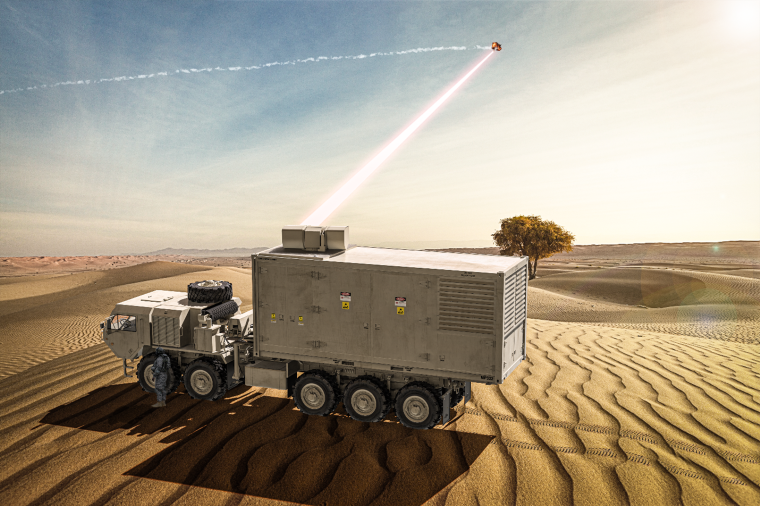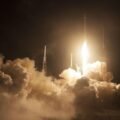Defense contractor Lockheed Martin is aiming to increase the already staggering power of their most powerful combat laser ever to a cruise-missile-destroying 500 kilowatts (kW) of pure energy.
Currently, the most powerful laser ever delivered to the Department of Defense packs a blistering 300 kW of energy. Now, the latest power increase is yet another step forward for the accelerating development and deployment of cutting-edge directed energy weapons.
Combat Laser Weapons Increasingly Entering the Field of Battle
In the days of President Ronald Reagan’s Star Wars initiative, the U.S. military began testing a chemical laser that they hoped would one day be able to knock Intercontinental Ballistic Missiles (ICBMs) from the sky. Unfortunately, the designers soon discovered that the technology wasn’t nearly ready, as even the weakest of combat laser designs took up entire buildings to operate.
In the last decade, dramatic improvements in optical technology and laser systems have led to a handful of practical combat lasers. The most powerful is in the hands of the Israeli Ministry of Defense. Dubbed Iron Beam, that system has grown from tens of kilowatts of power in 2016 to a robust 100 kW in 2023.
Still, weapons like Iron Beam or smaller combat laser systems in testing and development by the U.S. Navy, the U.S. Air Force, and the U.S. Army don’t come close to being able to counter many airborne threats, least of all ICBMs. Instead, they are most useful against drones or mortars, whereas missile attacks are still countered by anti-missile missiles.
That may soon change, as Lockheed’s 300 kW laser was shown downing a simulated cruise missile just last year. And based on their goals of upping that figure to 500 kW, their DOD customers may finally be getting closer to the holy grail of combat laser systems.
500 kW HELSI Will Be the Most Powerful Combat Laser Ever Developed
Under a contract from the Department of Defense’s Office of the Under Secretary of Defense for Research & Engineering, OUSD (R&E), the 300 kW laser already in use is part of the company’s High Energy Laser Scaling Initiative (HELSI). That same program says they are increasing that system to 500 kW by leveraging some of the optical and technical breakthroughs made during the years of working on combat laser systems for the DOD.
“OUSD (R&E) has invested to mature high energy lasers in support of America’s warfighters,” said Rick Cordaro, vice president of Mission Systems & Weapons at Lockheed Martin. “At the same time, Lockheed Martin has invested in our production infrastructure in anticipation of the Department of Defense’s demand for laser weapons that have additional layers of protection with deep magazines, low cost per engagement, high speed of light delivery, and high precision response reducing logistics requirements.”
It is those specific benefits that have continued to drive the efforts to make lasers bigger and more powerful while remaining relatively portable and cost-effective.
According to the company, the cost of deploying a conventional missile system for air threat defense is about the same as deploying one of their combat laser systems. But unlike conventional missile systems, the cost of operating the laser is significantly less. One estimate of the 100 kW Iron Beam placed that cost at a few dollars per shot compared to the price of a missile, which can range from $50,000 to $150,000 per launch.
Israel has successfully tested the new “Iron Beam” laser interception system.
This is the world’s first energy-based weapons system that uses a laser to shoot down incoming UAVs, rockets & mortars at a cost of $3.50 per shot.
It may sound like science fiction, but it’s real. pic.twitter.com/nRXFoYTjIU
— Naftali Bennett בנט (@naftalibennett) April 14, 2022
Also, as long as there is a power generator, the laser never runs out of ammo. In fact, much of the cost of operating mobile missile systems is in the purchase and transport of munitions. With a laser, the only cost is power.
“The initial cost of a missile battery is comparable to deploying a laser weapon system,” explained Scott Davidson, Chief Engineer at Lockheed Martin Missiles and Fire Control (MFC), “but once you get a laser in place, the cost per shot is less, and that’s where the LLD (Layered Laser Defense) is a game changer.”
According to the press release announcing the HELSI power upgrade, “The 500 kW-class laser will be tactically configured, utilize Lockheed Martin’s proven spectral beam combined architecture to support military platforms, and incorporate Department of Defense Modular Open System Approach standards to ensure the systems interoperability and multi-mission integration.”
The spectral beam combined architecture, in particular, is one of the most significant breakthroughs in laser designs. Previously, attempts to increase the power of lasers to make them viable for combat deployment consistently failed. Then Lockheed designers found that if they used an array of lasers operating at different wavelengths, they could combine them into one coherent beam while also increasing the power. That method of adding power to lasers is now considered the gold standard and is used by laser systems under development around the world.
500 kW Combat Laser Still Won’t Blast Targets from the Sky, but it is Getting Close
While this latest power increase is significant, the designers of the HELSI system caution that they are still a long way from science fiction lasers that blast enemy aircraft and missiles clean out of the sky. Instead, combat laser systems must focus on a target and effectively burn a hole through it until it cannot fly anymore. But if the laser does hit the vehicle’s fuel or warhead, it could result in a rather spectacular explosion.
Ultimately, the DOD sees these types of systems as compliments to conventional weapons and not direct replacements. However, as lasers continue to increase in power and efficiency, they may ultimately become the first line of defense, with conventional missile systems used in only the most extreme of circumstances.
“I don’t see lasers replacing missiles, but they could complement our current missile defense capabilities,” said Davidson. “I think the combination of missiles and lasers – kinetic energy and directed energy – offers a very lethal and broad range of defense for our warfighter to keep them safe and to keep our assets protected.”
Read More: Lockheed Martin Delivers DOD the Most Powerful Combat Laser Ever Built
Christopher Plain is a Science Fiction and Fantasy novelist and Head Science Writer at The Debrief. Follow and connect with him on X, learn about his books at plainfiction.com, or email him directly at christopher@thedebrief.org.

